Part 6
SPANISH AMERICAN WAR
Saunders Co. did her part in filling the ranks of the American Army for the Spanish-American War, 1898. A reception was held on Sept. 7, 1899 for the return of these men. The banquet was held in a large tent on the Wahoo School Campus; the program was held at the Courthouse Grove.
The following is a partial list of the boys from this county who went to this war; Lt. Henry Fingado, Philip Nelson, Rufus Stean, Earl Daharsh, Theron Steen, Frank Morrow, Ralph Dech, John Iverson, Roy Nethaway, James Phelan, Fred Gibbs, Gus Swanson and Pete Peterson.
OCCUPATIONS
Well digging was an early occupation in the Sand Creek area in the 1890's. Jesse Gidley was a well digger. He dug wells around the Sand Creek area. Bill Gidley also had well digging equipment and would travel way to Boone County to dig wells for small communities. He spent several weeks over by Wolbach, Nebraska, with this early occupation along with farming in the Sand Creek Area.
First well drillers were Crawford and Holtz of Wahoo. They were artists with the peach sapling when occasion demanded. They were Wahoo's first "Water Commissioners."
ICE STORAGE IN THE OLDEN DAYS
In the fall of 1916, my father, Peter Edward Anderson, and, sons David and John August, made a dam across Wahoo creek at the lower end of our place, which was located in Mariposa precinct, Saunders County.
All four of us children were born and raised on the N 1/2 of the NW 1/4. Father also owned the NW 1/4 of the NE 1/4 and the SE 1/4 of the NW 1/4, all in S 32. There are just my sister, Lilly, and I living at present.
We did have pretty cold winters in those days and eventually the ice did freeze to a good thick depth. When it was about 12 to 14 inches thick, it was ready to be cut and put into the ice house to be stored for summer use.
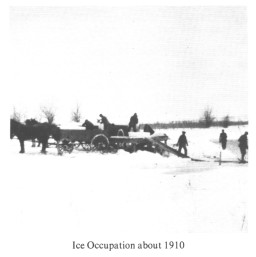 |
| Ice Occupation about 1910 |
An ice saw was used to cut it into long strips. A horse pulled the ice saw which a man would guide as they went along. Then it was cross cut into 36-inch pieces by not cutting clear through the ice. A chisel bar was used to break them into regular pieces and a man with a pike pole would push or pull them up to a wooden chute which came almost to the water's edge and reached up the embankment to where the wagons would load. These pike poles had two hooks, one bent forward toward the handle and the other bent away, so the chunk of ice could either be pushed or pulled. The horse wore shoes with four sharp bolts screwed into the regular horse shoe. These bolts could be removed and sharpened if they got dull.
When the ice was maneuvered to the chute a steel hook and cable were attached to the piece and a horse pulled it up into the wagon. The pieces had to be picked up with ice tongs and arranged so that they would fit in without too much waste space.
Then it was hauled to the ice house, which was a hole in the ground with a roof over it. It was located fairly close to the house. Much straw was used to put under and around and over the cakes of ice. A lot of straw was piled on top to help keep it cool.
Several neighbors came to get ice to put in their ice houses.
Then before summer arrived, everyone had to buy an ice box.
When milk and cream would no longer stay sweet all day in a tank in the milk house, where the water ran through to the horse tank outside, it was time to get some ice into the ice box. Then we could have chipped ice in lemonade and ice tea.
What a step-saver that was to every farm wife, to have the milk, cream and butter in an ice box in the house.
It also was marvelous to have homemade ice cream and invite the neighbors in to help eat it. by Carl G. Nygren
WILLIAM CAHA ORCHARD
William Caha (1879 - 1962), son of Joseph and Marie Caha, received national recognition for his work in propagating the different species of trees which can be found in his orchard 6 miles southwest of Wahoo. He may have gained his love of trees when helping his father plant trees on the bare prairie.
William Caha started the orchard in the early 1900's primarily with fruit trees, but many of them died during the great drought of the '30's. After that, he decided to plant a nut nursery. Many of the original trees, which he did not have time to transplant, are still standing in their original rows. In this orchard could be found nuts and fruit such as pecans, hickory, hickan (a cross between pecan and hickory), American and Chinese chestnuts, black walnut, persimmons, apricots, filberts, apple, blackberry and raspberry. Caha created several new varieties as a result of grafting and cross-breeding. Over the years other new varieties have sprung up naturally through wind pollination. The orchard has at times provided fruit and nuts for the whole community.
Thinking it only natural to have different kinds of nuts, such as pecans, hickory, walnuts and persimmons during the winter, the Caha children realized only much later the uniqueness of the orchard. Dr. Hans Burchardt, a University of Nebraska horticulturist, accidentally stumbled upon this orchard and immediately sought out its owner. He was able to discuss Caha's achievements a few times before the latter's death. Dr. Burchardt, who is German-born and has worked in Africa and Jamaica, immediately realized the orchard's significance.
The species in the orchard are not ordinarily cultivated in Nebraska, the climate of which is considered too cold and harsh. In the United States, commercial cultivation of these nuts is carried on much further to the east and south. William Caha was able to make these species hardy enough to survive and to reproduce themselves without any care.
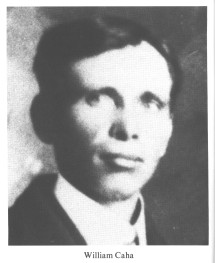 |
| William Caha |
Dr. Burchardt alerted the University and also made contact with William Caha's heirs after his death. The University Horticulture Department and the State Game Commission obtained permission to use this orchard for further experimentation; plans for a future arboretum are under discussion. For the last 20 years, the orchard has been an experimental station for the University Horticulture Department and many of its trees adorn the highways; plantings of trees from the Caha orchard are also growing beautifully at the Hans Burchardt Arboretum at Branched Oak Lake, near Lincoln. The information about the new strains from the orchard have helped the University of Nebraska in its project of developing hardy strains of pecan and other nut trees that will thrive naturally in the Nebraska climate or even further north. The Caha orchard has been allowed to grow naturally, without cultivation, and plantings are taken to the University or other experimental sites for further research. Producing strains of nuts that could be cultivated on the northern Great Plains was the hope of William Caha, and the work is being carried on in his spirit.
As Dr. Burchardt stated, "This is the Caha Orchard today. I compare it with a cradle, a cradle for plant life, new creations for Nebraska, for the Midwest. A wonderful man started it, cared for it, invested money in it, but did not count on profit. He enjoyed it. I am proud and happy to have known him. William Caha. He faded away, but the orchard lives, with him, with his name ... He was a true pioneer - equal to Old Jules [Sandoz, whose early-day fruit orchards are still producing in the northwest Nebraska sandhills] ... He proved for 25 years that these trees can start and grow without help." The Caha orchard is now (1983) owned by a niece, Martha Caha Pecena. It is now taking its own wild course, unchartered and virtually untended. The University horticulturists hope it can be preserved for further study and testing.
SILVER CREEK ICE HARVEST
One of the farms in Saunders County where ice was harvested was that of John Nygren in the NW 1/4 S 4, Wahoo Precinct. The pond on which this was done was the original channel of Silver Creek. Another channel had been cut for the creek.
The first ice was sawed by hand by Mrs. Nygren's brother, Carl Swanson, and his cousin, Martin Carlson, in 1907. They had three customers: Tom Snelling, J.M. Rockwell and Jacob Lampert. The cost per wagonload was 25 cents.
After two winters of this, John Nygren took over the operation. He bought a horse-drawn ice plow, ice saws and tongs, and either made or had made long-handled pikes to push or pull the ice cakes to the loading point, and ice spuds. He built a wagon-floor level loading platform, large enough that at least three wagons could back in to it at a time, and with a ramp from the water level. With the aid of a horse, a rope and a homemade hook, three or four cakes were hauled to the platform at a time. These ice cakes were about 16 inches wide, 30 inches long, and as thick as weather permitted, up to 12 inches.
I believe the plow was used to cut the long dimension of the ice cake. The depth would depend on the thickness of the ice, possibly half depth of 12-inch ice. The other right-angle cut would have been more as a mark for the sawmen. After sawing the ends, the long dimension was easily spudded to break out the cake. Plowing and sawing started about 4 o'clock in the morning.
It required seven or eight men to produce the ice cakes fast enough so the price was raised to fifty cents a load. Eventually, the price was set at seventy-five cents per load to cover expenses.
The ice campaign lasted five or six days, with 70 to 100 wagon loads per day. Carl Swanson said in some winters 500 to 600 loads were hauled away.
This ice harvesting continued until the first World War influenza epidemic (1918-1919) effectively put a stop to it. By then ice could be purchased in Wahoo, and soon after that (1921 or 1922), electricity came to the farms and refrigerators came into vogue.
page 18
The farmers who "put up" ice usually made an ice house by digging a square or rectangular hole eight to ten feet deep and building a roof over it. By packing it in oat or wheat straw, ice usually lasted through the summer.
There was at least one other location in the county where ice was harvested from Silver Creek. This was on the Charles E. Olson farm two miles east of Colon on the NW 1/4 of S 8, Marietta Precinct. Mr. Olson had built a dam on Silver Creek, and ice was gathered from the resulting pond. by Mrs. Edmund Quincy
LINCOLN ROAD THRESHER COMPANY
During the summer of 1913, farmers who lived along and near Lincoln Road in Saunders County, south of Cedar Bluffs, were having trouble finding someone to thresh their grain, so they decided to buy their own rig.
The following is from a paper, yellow with age, dated July 21, 1913: "We the undersigned do hereby agree to pay our full share towards the payment of a complete threshing outfit, not to cost more than three thousand dollars ($3000.00)." Signed by: J.F. Lubker, Wm. C. Haxby, Robert Haxby, O.H. Sholts, Bert Fauquet, A.O. Smith, Nels Paulsen, John Knutzen, Hans Jurgens, and Peter Lubker.
So, in the fall of 1913, they became the owners of a Nichols and Shephard Steam Engine and Separator for the price of $2770.00. It was shipped to Cedar Bluffs by rail on a flat car, and caused a lot of comment on account of the enormous wheels on the engine.
Nels Paulsen was engineer the first year, and Pete Lubker was separator man. After that, Ben Haxby was engineer and kept that job until the company discontinued business in 1941, when the use of combines was becoming prevalent.
Bill Haxby was the first "Tankie" on the water wagon. John Lubker kept the records.
The fields of grain were cut early in July. Wheat, oats, and barley were cut with a binder, which tied the grain in bundles. Then the men and most women would pick up and set 8 bundles to make a shock. The bundles weighed 20-25 pounds. The wheat was always threshed first, each farmer getting his turn. Then, the oats and barley were threshed on the second round.
The farmers were charged according to the total bushels of grain threshed. Most was measured by a 52-bushel level wagon box. During the hard times, farmers sometimes traded grain as payment.
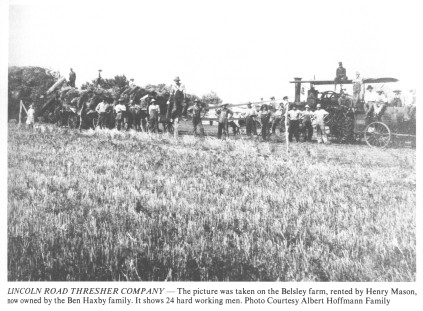 |
| LINCOLN ROAD THRESHER COMPANY - The picture was taken on the Belsley farm, rented by Henry Mason, now owned by the Ben Haxby family. It shows 24 hard working men. Photo Courtesy Albert Hoffmann Family |
As farmers retired, their sons usually took their place in the crew. Some of the farmers on the route besides the owners were: Fred Hoffmann, Henry Mason, George and Otto Gabriel, Claus, George, and John Mahrt, Andrew Gabriel, Steve Burke, Rudolf, Hans, and Albert Hoffmann, Elmer Jurgens, A.J. Knutzen, and Carl Douthit, to name just a few.
Not to be forgotten were the women who cooked the delicious meals. They worked over a hot cook stove with not even a fan to alleviate the summer heat. The men would wash up for the meal at a long bench with 3 or 4 wash basins of water, and a water bucket on the end. There would be a mirror hanging on a tree close by and one comb to be used by all.
It was always a happy time for the children, too, with all the commotion going on, when the "Threshers" came!
After a tornado blew down the shed in which the rig was stored, the company held a sale in 1943 and the engine was sold to Ray Malloy for $62 for junk. Later, however, it ended up in Hooper, Nebraska. There it was used by the contractors at the Scribner Air Base. Submitted by Mr. and Mrs. Henry Lubker
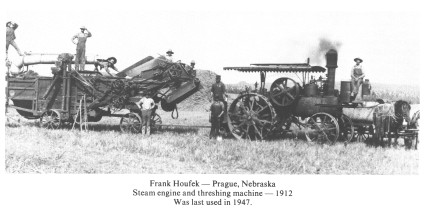 |
Frank Houfek - Prague, Nebraska
Steam engine and threshing machine - 1912
Was last used in 1947. |
"FLIES"
During threshing time farm women helped one another with cooking and baking to feed the men in the crew. The children helped bring in water, cobs and wood.
Just before dinner, the men washed up under a tree in the yard.
The women and girls drew the shades to darken the dining room and kitchen. Arming themselves with dishtowels, they waved them hard, starting from the wall farthest from the open door. The flies were chased outdoors. Even with doors and windows covered with screens, many flies came in to the smell of food. Children going in and out let them in.
There was much manure in farmyards from the horses, cattle, hogs, and poultry and flies were a big problem as there were no effective chemicals to control them. "Daisy" flykillers and treated black paper, moistened in a saucer of water with a little sugar, killed many flies.
A cage made of window screen over a wooden frame had a screen cone over a hole in the cage floor. A small opening at the cone's top let the flies in, but they couldn't find a way out. A dish of bait, like stale beer, drew the flies under the cage. They naturally flew upward and entered the flytrap.
Flies in the trap for a few days died. The rest were killed with scalding water poured over them and the cage was emptied from an opening in the top. Submitted by Ella Travnicek
EARLY 1900's
In the early 1900's, the farmers in Saunders Co. were beginning to put the early struggles of pioneer days behind them. A great boom in agriculture was beginning to take place and by the 1920's agriculture in the county was having a heyday. If the farmers prospered so did the small villages and towns. The U.S. was becoming a world power. Large homes were built on the farms and in the towns. Many of the familiar big square white farm homes still are in existence today.
Crop prices were very good; in fact, when bad times have struck the farmers again and again, he has looked back to the period between 1910-1914 as the base period on which to form his claim for "agriculture equality". Those years gave him his parity formula. (The parity price for a particular farm product is that price which gives a farmer the same purchasing power that he had during this base period prior to WW I.) This idea that the purchasing power of the farmer should not fall below a certain percentage of that of industrial workers still prevails today. However, it is a rare time, indeed, when the farmer can even come close to achieving parity. It did mount during WW II, reaching a peak of 110% in 1943. But in 1983, (40 yrs. later) parity seems like a lost dream with farmers not even receiving the cost of production for their crops.
HISTORY OF POHOCCO WOMEN'S CLUB
On November 20, 1901, a small group of rural women living in the community where Union, Marietta and Pohocco precincts join, decided to organize a Woman's Club.
Club histories show that Miss Frances Moore was the first president; vice president, Mrs. Jay Willey; secretary, Mrs. Paul Williams and treasurer, Miss Kate Thompson.
page 19
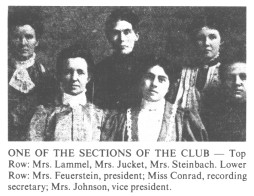 |
| ONE OF THE SECTIONS OF THE CLUB -- Top Row: Mrs. Lammel, Mrs. Juckett, Mrs. Steinbach. Lower Row: Mrs. Feuerstein, president; Miss Conrad, recording secretary; Mrs. Johnson, vice president. |
Other charter members were Lizzie Golliglee, Emily McClean and Mmes. Martha Moore, William Estey, Blaine McCord, Mary Hannan, C.J. Conrad, Ansel Juckett, Joe Davis, John Lammel, J.N. Frahm and A.M. Maxwell.
On New Year's Day, 1902, the group adopted a constitution and joined the state and national federation. At this meeting the following names were added to the roll: Tina Wicklund, Anna Carey and Mmes. Ida Loder, Mary A. McClean, George Willey, George Pegden, William Weaver, Roy Conrad and Louis Nelson.
Pohocco was chosen for the club's name because of its Indian origin and the fact that most of the members lived in that precinct.
The club was a real pacesetter in the community being one of the very earliest in the County. Their programs were ambitious and included music, book reports, recitations and current news reports at each meeting. Their motto was: Read not to contradict, but to weigh and consider. They started their meetings at 11:00 A.M. and went on till 4:00 or 4:30 PM.
To their everlasting credit the husbands of the members were very supportive of the club. They soon became the most enthusiastic promoters because they saw the great value of the organization. One of the most exciting programs each year was the final one in December called a Pow-wow. The men prepared the meal, planned the entertainment and paid special tribute to the wives. In 1908, D.H. Thompson was in charge of the program which was entitled "Women's Rights". Over 100 members and guests attended this Pow-wow at the home of Mr. and Mrs. George Willey. That year the president of the club was Mrs. Maggie Feuerstein, vice-president was Mrs. Charles Johnson, and recording secretary was Miss Sadie Conrad.
Many community projects were part of the club's activities down through the years. Members planted trees on country school yards and placed framed copies of the "Moral Code" in the school house.
Before 4-H work was begun, the club sponsored organizations and contests for the children in the community. Gardening and poultry raising were encouraged.
One of the club's proudest achievements was the sponsorship of the Covered Wagon Area Troop 147, the first mounted boy scout troop in the midwest. The only mounted troop in Nebraska was reorganized at a boy scout circus in the Omaha coliseum. They also rode in an Armistice Day parade in Fremont. The troop which was organized November 7, 1930, included: William Hannan, Clifford Hollenbeck, Wilder and Donald Feuerstein, Earl Krumel, Harold Feist, Malcolm McClean, Charles Golliglee, Homer Christensen, Duane Moody, Norman Stevens, Bernard Siebken and Richard Burt.
Down through the years, the organization contributed to the Salvation Army, orphanages, crippled children, Red Cross, Cancer Fund and other agencies. During both World Wars, the members were actively engaged in Red Cross volunteer work.
The Pohocco Woman's Club celebrated its 50th anniversary October 31, 1951 at the home of Mrs. W.W. Feuerstein. This was the same home in which the first meeting of the club was held. Submitted by Muriel Bishop Witte and Dorothy Boettner
| 
